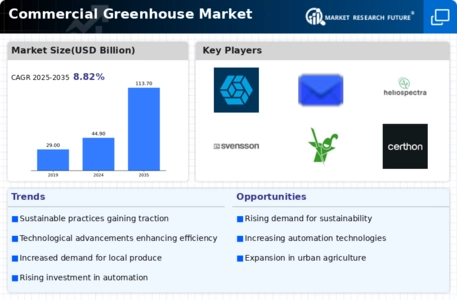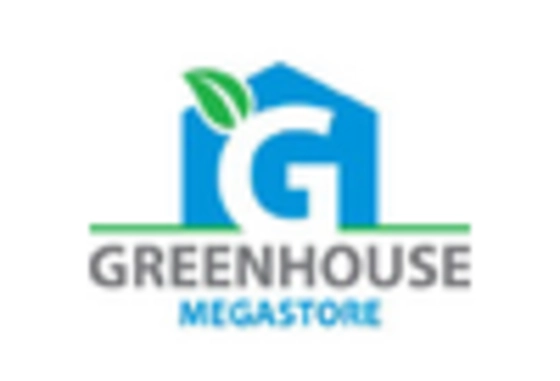Rising Demand for Fresh Produce
The increasing consumer preference for fresh and locally sourced produce is a primary driver in the Commercial Greenhouse Market. As health-conscious consumers seek organic and pesticide-free options, the demand for greenhouse-grown vegetables and fruits has surged. According to recent data, the market for organic produce has expanded significantly, with sales reaching approximately 50 billion dollars in the last year. This trend is likely to continue, as more consumers prioritize quality and sustainability in their food choices. Consequently, commercial greenhouses are positioned to meet this demand by providing fresh produce year-round, thereby enhancing their market presence and profitability.
Government Support and Incentives
Government initiatives aimed at promoting sustainable agriculture are significantly influencing the Commercial Greenhouse Market. Various countries have introduced subsidies and grants to encourage the establishment of commercial greenhouses, recognizing their potential to enhance food security and reduce carbon footprints. For example, funding programs for energy-efficient greenhouse technologies have been implemented, which can cover a substantial portion of initial investment costs. This support not only lowers barriers to entry for new growers but also incentivizes existing operations to upgrade their facilities. As a result, the commercial greenhouse sector is expected to experience robust growth, driven by favorable policy frameworks.
Urbanization and Space Constraints
The rapid pace of urbanization is creating unique challenges and opportunities within the Commercial Greenhouse Market. As urban populations grow, the demand for locally produced food increases, leading to a rise in urban greenhouse projects. These facilities can be established in limited spaces, such as rooftops and vacant lots, making them an attractive solution for urban food production. Data suggests that urban agriculture could potentially supply up to 30 percent of the food needs in metropolitan areas. This trend is likely to encourage investment in commercial greenhouses, as they provide a viable means to address food supply challenges in densely populated regions.
Consumer Awareness of Environmental Impact
There is a growing awareness among consumers regarding the environmental impact of food production, which is driving change in the Commercial Greenhouse Market. As consumers become more informed about the benefits of sustainable practices, they are increasingly favoring products that are grown in environmentally friendly conditions. This shift is prompting commercial greenhouse operators to adopt sustainable practices, such as water conservation and renewable energy use. Market analysis indicates that products labeled as sustainably grown can command higher prices, thus enhancing profitability for greenhouse operators. This trend is expected to continue, as consumer preferences increasingly align with sustainability.
Technological Innovations in Greenhouse Design
Technological advancements in greenhouse design and management systems are transforming the Commercial Greenhouse Market. Innovations such as automated climate control, advanced irrigation systems, and energy-efficient lighting are enhancing productivity and reducing operational costs. For instance, the integration of IoT devices allows for real-time monitoring of environmental conditions, leading to optimized growth conditions for crops. Reports indicate that greenhouses utilizing these technologies can increase yield by up to 30 percent compared to traditional methods. As these technologies become more accessible, they are likely to drive further investment in commercial greenhouses, fostering growth in the industry.

















Leave a Comment